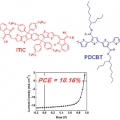
Higher Quantum State Transitions in Colloidal Quantum Dot with Heavy Electron Doping
| author | Kwang Seob Jeong |
|---|---|
| Homepage | https://sites.google.com/site/ksjkulab/ |
| journal | J. Phys. Chem. C, Just Accepted Manuscript (DOI: 10.1021/acs.jpcc.6b07331) |
Electron occupation in the lowest quantized state of the conduction band (1Se) in the colloidal quantum dot leads to the intraband transition in steady-state (1Se-1Pe). The intraband transition, solely originating from the quantum confinement effect, is the unique property of semiconducting nanocrystals. To achieve the electron occupation in 1Se state in the absence of impurity ions, non-thiol ligand passivated HgS colloidal quantum dots are synthesized. The non-thiol ligand passivated HgS quantum dot exhibits strong steady-state intraband transition in ambient condition and enables a versatile ligand replacement to oxide, acid and halide functional ligands, which was not achievable from conventional HgS or HgSe quantum dots. Surprisingly, the atomic ligand passivation to HgS colloidal quantum dot solution efficiently maintains the electron occupation at 1Se of HgS CQDs in ambient condition. The electron occupation in 1Se of HgS CQD solid film is controlled by surface treatment with charged ions, which is confirmed by the mid-IR intraband absorption (1Se-1Pe) intensity imaged by the FTIR microscope. Furthermore, a novel second intraband transition (1Pe-1De) is observed from the HgS CQD solid. The observation of the second intraband transition (1Pe-De) allows us to utilize the higher quantized states that were hidden for the last three decades. The use of the intraband transition with narrow bandwidth in mid-IR would enable to choose an optimal electronic transition occurring in the nanocrystal for a number of applications: wavelength-selective low-energy consuming electronics, space-communication light source, mid-infrared energy sensitized electrode and catalyst, infrared photodetector and infrared filter.

-
Read More

Highly Efficient Fullerene-Free Polymer Solar Cells Fabricated with Polythiophene Derivative
Han Young Woohttp://www.ooml.korea.ac.kr/A highly efficient fullerene-free polymer solar cell (PSC) based on PDCBT, a polythiophene derivative substituted with alkoxycarbonyl, has achieved an impressive power conversion efficiency of 10.16%, which is the best result in PSCs based o...Date2016.09.29 ByManager Views2970 -
Read More

Low-voltage organic devices based on pristine and self-assembled monolayer-treated HfTiOx gate dielectrics
Jong-Ho Choihttp://neslab.campushomepage.com/index2.aspLow-voltage organic field-effect transistors (OFETs) and complementary metal oxide semiconductor (CMOS) inverters based on pentacene and N,N′-ditridecylperylene-3,4,9,10-tetracarboxylic diimide (PTCDI-C13) were fabricated on HfTiOx gat...Date2016.09.20 ByManager Views1343 -
Read More

Higher Quantum State Transitions in Colloidal Quantum Dot with Heavy Electron Doping
Kwang Seob Jeonghttps://sites.google.com/site/ksjkulab/Electron occupation in the lowest quantized state of the conduction band (1Se) in the colloidal quantum dot leads to the intraband transition in steady-state (1Se-1Pe). The intraband transition, solely originating from the quantum confinemen...Date2016.09.20 ByManager Views1668 -
Read More

High-harmonic generation: Drive round the twist
Minhaeng Chohttp://cmsd.ibs.re.kr/html/cmsd_en/Light has long been used to detect the chirality of molecules but high-order harmonic generation now provides access to these chiral interactions on ultrafast timescales. http://www.nature.com/nphys/journal/v11/n8/full/nphys3395.htmlDate2016.09.20 ByManager Views1153 -
Read More

Gradients of Rectification: Tuning Molecular Electronic Devices by the Controlled Use of Different-Sized Diluents in Heterogeneous Self-Assembled Monolayers
Hyo Jae YoonMolecular electronics has received significant attention in the last decades. To hone performance of devices, eliminating structural defects in molecular components inside devices is usually needed. We herein demonstrate this problem can be ...Date2016.07.29 ByManager Views1476 -
Read More

Investigation of Charge Carrier Behavior in High Performance Ternary Blend Polymer Solar Cells
Han Young Woohttp://www.ooml.korea.ac.kr/This study demonstrates high-performance, ternary-blend polymer solar cells by modifying a binary blend bulk heterojunction (PPDT2FBT:PC71BM) with the addition of a ternary component, PPDT2CNBT. PPDT2CNBT is designed to have complementary ab...Date2016.07.29 ByManager Views1211 -
Read More

Adsorption of Carbon Dioxide on Unsaturated Metal Sites in M2(dobpdc) Frameworks with Exceptional Structural Stability and Relation between Lewis Acidity and Adsorption Enthalpy
Chang Seop Honghttp://immlab.korea.ac.kr/A series of metal–organic frameworks (MOFs) M2(dobpdc) (M=Mn, Co, Ni, Zn; H4dobpdc=4,4′-dihydroxy-1,1′-biphenyl-3,3′-dicarboxylic acid), with a highly dense arrangement of open metal sites along hexagonal channels wer...Date2016.07.29 ByManager Views3005 -
Read More

Programmed activation of cancer cell apoptosis: A tumor-targeted phototherapeutic topoisomerase I inhibitor
Jong Seung Kimhttp://orgchem.korea.ac.kr/index2.aspWe report here a tumor-targeting masked phototherapeutic agent 1 (PT-1). This system contains SN-38—a prodrug of the topoisomerase I inhibitor irinotecan. Topoisomerase I is a vital enzyme that controls DNA topology during replication,...Date2016.07.29 ByManager Views9521 -
Read More

Probing Distinct Fullerene Formation Processes from Carbon Precursors of Different Sizes and Structures
Hugh I Kimhttps://sites.google.com/site/hughkimgroup/Fullerenes, cage-structured carbon allotropes, have been the subject of extensive research as new materials for diverse purposes. Yet, their formation process is still not clearly understood at the molecular level. In this study, we performe...Date2016.07.29 ByManager Views2733 -
Read More

Manifesting Subtle Differences of Neutral Hydrophilic Guest Isomers in a Molecular Container by Phase Transfer
Hugh I. Kimhttps://sites.google.com/site/hughkimgroup/Achieving strong host–guest interactions between synthetic hosts and hydrophilic guests in solution is challenging because solvation effects overwhelm other effects. To resolve this issue, we transferred complexes of cucurbit[7]uril (C...Date2016.07.29 ByManager Views1348
Designed by sketchbooks.co.kr / sketchbook5 board skin
 Low-voltage organic devices based on pristine and self-assemb...
Low-voltage organic devices based on pristine and self-assemb...
 High-harmonic generation: Drive round the twist
High-harmonic generation: Drive round the twist